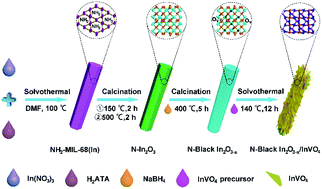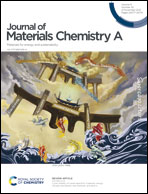Novel N-Black In2O3−x/InVO4 heterojunction for efficient photocatalytic fixation: synergistic effect of exposed (321) facet and oxygen vacancy†
Abstract
Utilizing semiconductors to catalyze the conversion of N2 to NH3 has brought great promise in alleviating the issue of energy shortage. However, the wide band gap and high recombination rate of photogenerated (e−/h+) charge restrict their photocatalytic efficiency. Herein, a novel catalyst, N-Black In2O3−x/InVO4 was developed by coupling InVO4 nanosheets into defect-rich N-Black In2O3−x nanorods to construct multiple heterojunctions using the NH2-MIL-68(In) metal–organic-framework as a template. The N-Black In2O3−x/InVO4 multiple heterojunctions with oxygen vacancies could expand the light absorption range, act as electron trap centers, promote the separation of photogenerated carriers, and significantly improve the adsorption as well as activation of N2. Density functional theory (DFT) calculations revealed that the exposed (321) planes of the N-Black In2O3−x possess a higher surface energy than the (222) planes, which indicates that the exposed (321) planes can adsorb more N2 molecules and transform them into NH3 molecules. Consequently, owing to the efficient separation of photogenerated carriers, the nitrogen fixation rate of the N-Black In2O3−x/InVO4 heterostructure was as high as 2.07 mmol g−1 h−1 without any organic scavengers and precious-metal cocatalysts, which was 20.7, 2.4, 2.1, and 1.8 times that of NH2-MIL-68(In), N-In2O3, InVO4, and N-Black In2O3−x, respectively.



 Please wait while we load your content...
Please wait while we load your content...